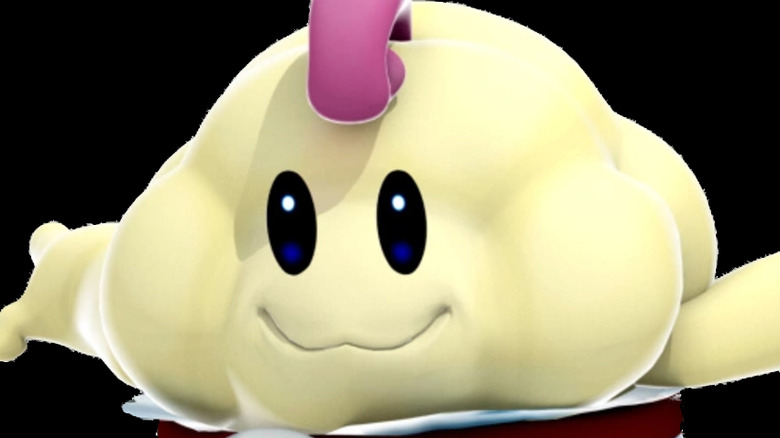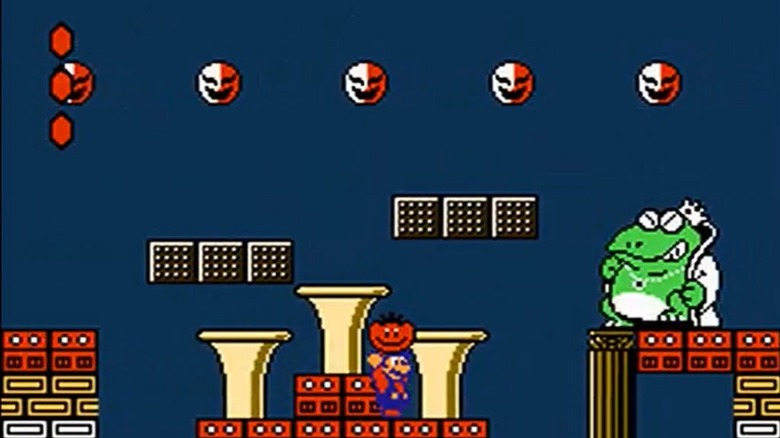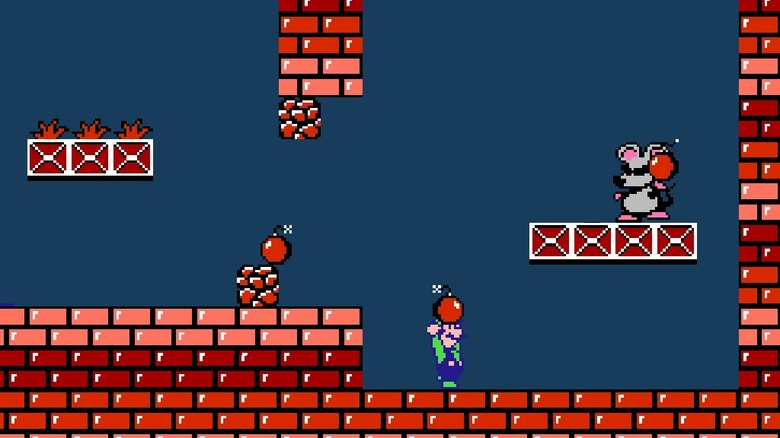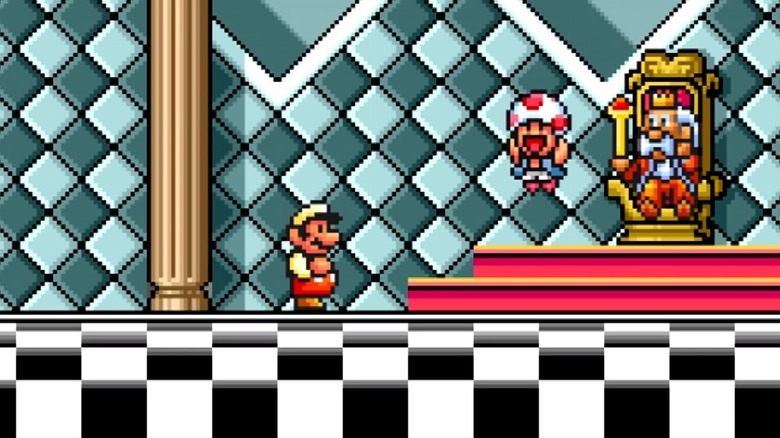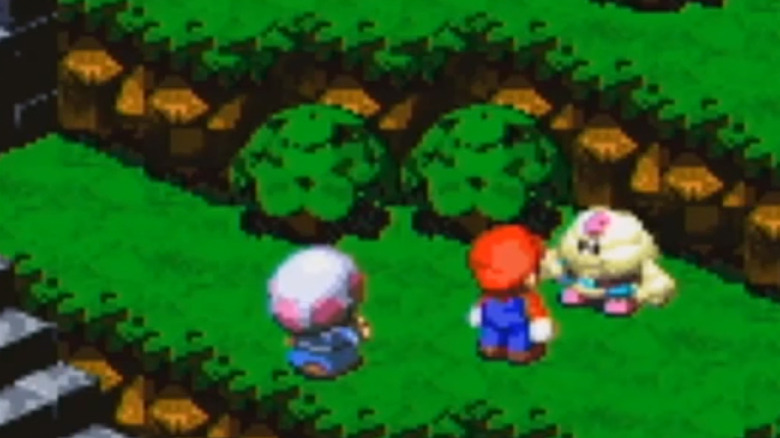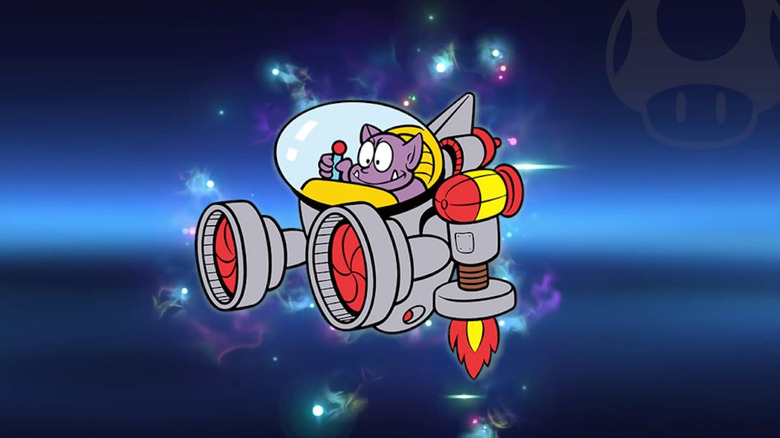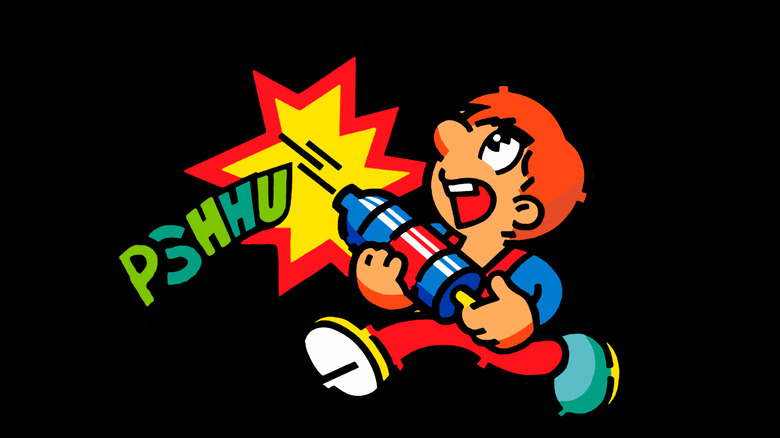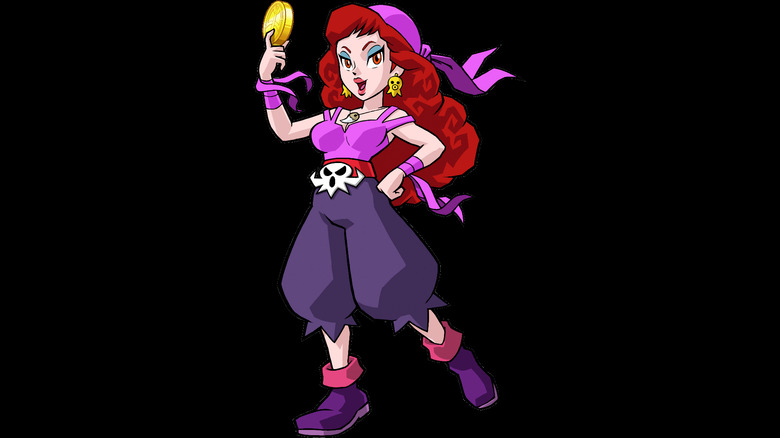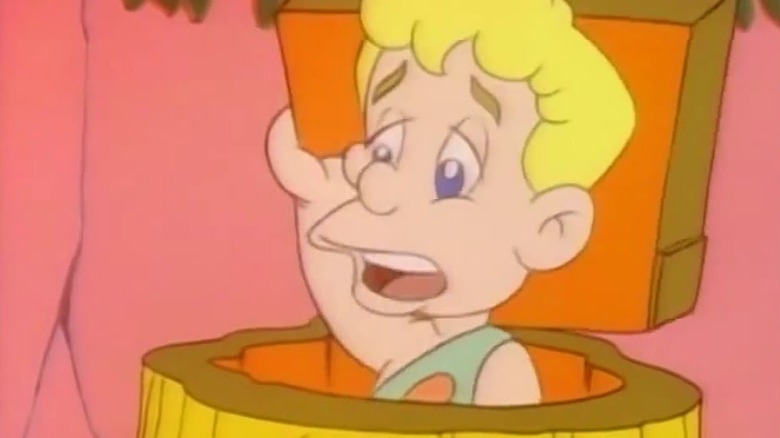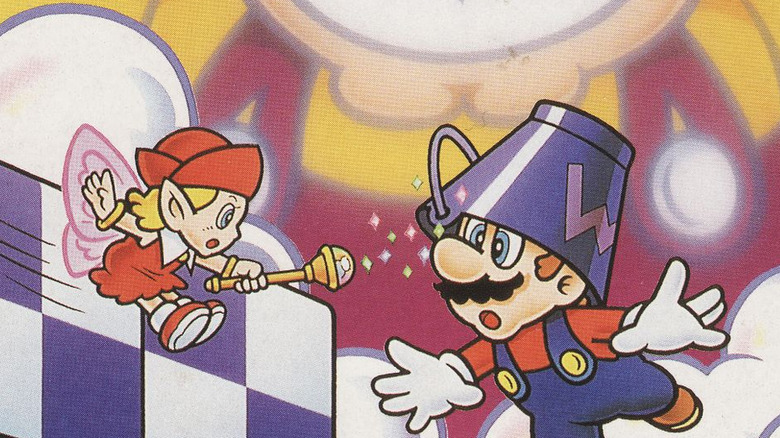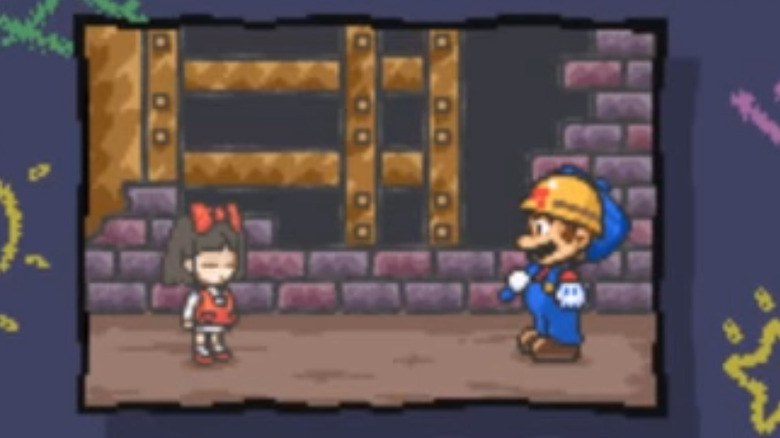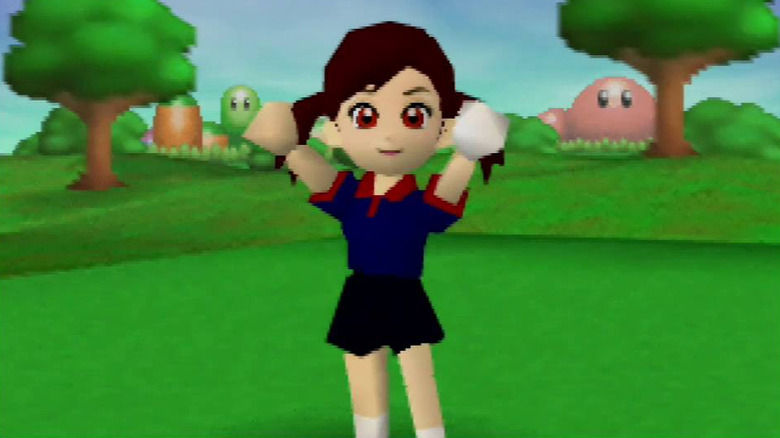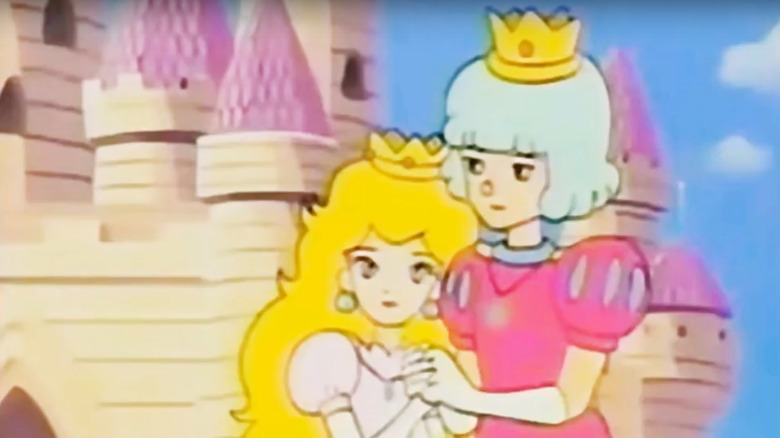Mario Characters That Have Mysteriously Disappeared
We may receive a commission on purchases made from links.
Mario is the biggest name in video games — at one point, he was more famous than Mickey freakin' Mouse — but he's not a solo act. Over the years, Nintendo's plucky little plumber has amassed a huge collection of friends, enemies, and everything in between. Thanks to their association with gaming's number one superstar, many of them have gone on to become celebrities in their own right, headlining games — and even entire franchises — of their very own.
And then there's everyone else. Mario has a big spotlight, but he also casts a large shadow, and not everyone who crosses Mario's path ends up benefiting. Every single one of the following Mario characters could've been a big deal (hey, if a pink dinosaur who shoots eggs out of her snout can become a star, pretty much anyone can). Instead, they vanished with nary a trace, doomed to be footnotes in history while Mario soaks up all of the attention. What a jerk.
Subcon's amphibious antagonist
Despite its odd, non-Mario lineage, Super Mario Bros. 2 — the American edition, that is — has become a key piece of Mario canon, and many familiar characters sprung from the inadvertent sequel. Shy Guys serve as recurring villains in the Mario series. Birdo has become a regular member of the Mario sports roster and serves as Yoshi's on-again, off-again love interest. The walking explosives known as Bob-ombs are a Super Mario fixture.
But what about Super Mario Bros. 2's big bad? According to the manual, Wart, leader of the 8-bit gang, created all of Super Mario 2's villains with a contraption known as the "dream machine." He's the one leading the charge to conquer Subcon, the land of dreams. As Super Mario Bros. 2's end boss, he's a Bowser-level threat. And yet, the pesky frog king has only appeared in that one game, give or take a weird cameo in Link's first portable adventure, the surprisingly Mario-heavy The Legend of Zelda: Link's Awakening.
Wart isn't forgotten, exactly. He's still the villain in various Super Mario Bros. 2 remakes. He's a spirit in Super Smash Bros. Ultimate, and he popped up in a few comics and a Choose Your Own Adventure-style novel back in the '80s. Some Mario spin-offs, like Paper Mario: Color Splash and Mario Superstar Baseball, drop his name in passing. Otherwise, however, Wart's henchman get all the attention. Wart himself is nowhere to be seen.
The bomb-chucking malevolent mouse
In the games, Mouser isn't a top-tier Mario villain. He's barely one step up from a goomba. In Super Mario Bros. 2, players fight the sunglasses-clad, bomb-chucking rodent twice — once at the end of World 1 and again at the end of World 3 — and that's pretty much the end of his story (Doki Doki Panic, the game that Super Mario Bros. 2 is based on, features a third Mouser fight, but that was cut in the transition to a proper Mario game).
In The Super Mario Bros. Super Show cartoon, however, Mouser plays a big, big role. The animated series, which premiered in 1989, mashed up elements of Super Mario Bros. and Super Mario Bros. 2 in an attempt to make sense of Mario's distinctly nonsensical world. In this new setting (and its comic book spin-offs), Mouser is King Koopa's second-in-command. He's mostly inept (he's a '80s cartoon henchman, after all), but still, that's a big role for an otherwise minor character.
You'd expect Mouser's small-screen fame would kickstart his Super Mario career — and you'd be very wrong. Other than the requisite appearances in remakes and as Super Smash Bros. collectibles, Mouser has only appeared in one other video game. In Super Mario Bros. & Friends: When I Grow Up, a digital coloring book for small children, Mouser plays a disc jockey. Judging by the art, he's not a very good one.
The Mushroom Kingdom's missing monarchs
The Mario series is full of weird stuff, and nothing is stranger than the Mushroom Kingdom's government. For one, why are fully grown humans lording over a race of squat mushroom people? For another, if Peach isn't the one in charge — and remember, she's only a princess, which implies that she's not — then where the heck are her parents?
In fact, where are any of the kings who rule over the Mushroom Kingdom and its surrounding lands? We know that they exist. For the bulk of Super Mario Bros. 3, Mario isn't rescuing princesses. He's battling on behalf of the fully-grown monarchs who have been transformed into animals after King Koopa and his minions swept through and stole their magic wands.
Super Mario Bros. 3 doesn't do much to set the kings apart, although the Adventures of Super Mario Bros. 3 animated series gives a few of them names and personalities. Still, they've got to be out there somewhere — unless, of course, Peach had them eliminated as part of a Game of Thrones-style power grab. Sounds ridiculous, sure, but until these long-lost monarchs show up again, we're not ruling anything out.
Nimbus land's confused cloud prince
With Super Mario RPG: Legend of the Seven Stars, Square — known in modern times as Square Enix — gave itself a seemingly insurmountable task: take Super Mario Bros., a game without much of a story, and give it a plot that's just as epic as anything from Square's own Final Fantasy series without losing any of that distinct Nintendo charm.
Despite all odds, Square succeeded. In part, that's thanks to the action-oriented combat system, which de-emphasized weapons and played up Mario's physical skills. Square's new, quirky characters played a big role, too. There was Smithy, the giant sentient sword who served as Super Mario RPG's main antagonist. There was Boshi, the spike-wearing, cookie-guzzling dinosaur. Most importantly, there were your two new party members: Geno, a doll possessed by a celestial entity, and Mallow, the long-lost prince of cloudy Nimbus Land.
Both Mallow and Geno quickly became fan favorites, but only one has withstood the test of time. Geno hasn't had a starring role since Super Mario RPG, but he makes a cameo appearance in Super Mario RPG's spiritual sequel, Mario & Luigi: Superstar Saga, and Super Smash Bros. for Nintendo 3DS and Wii U players can dress their Mii fighters in his signature garb. Mallow, though? He's a spirit in Super Smash Bros. Ultimate, and otherwise hasn't been seen since. Poor little guy. Mallow worked hard to save the world. Hopefully, at some point in the future, he'll get the respect — and return appearance — that he deserves.
Sarasaland's extra-terrestrial invader
Forget koopas. In Super Mario Land, aliens are the real threat. While Bowser is content with kidnapping a princess and taking over a single kingdom, Tatanga dispatches his army and conquers four of 'em. Where Bowser is easily dispatched by hopping on an axe and cutting the bridge out from underneath him, Mario must face Tatanga in a one-on-one duel high in the sky, where he's forced to use his biplane to decimate Tatanga's spaceship Independence Day-style.
All of that makes it seem like Tatanga, not Bowser, is the most dangerous foe that Mario has ever faced. As it turns out? Not so much. After wreaking havoc over Sarasaland in Super Mario Land, one of the very first Game Boy games released, Tatanga faded into relative obscurity. He popped up in Super Mario Land 2: 6 Golden Coins as a world-end boss, but his power is greatly diminished. In the Game Boy comic book series, Tatanga leaves the Game Boy and invades the real world, but Mario arrives to foil his plans once again.
Other than brief mentions in various Princess Daisy bios, that's the end of him. Even when Mario travels into space in Super Mario Galaxy, Tatanga isn't found anywhere. At least he's probably not lonely: Katsini, a minor character in Wario's Woods, looks an awful lot like the extraterrestrial warlord. Are there more small, purple creatures lurking in space's vast expanse? If so, we certainly wouldn't be surprised.
Donkey Kong's blue-collar nemesis (no, the other one)
Sometimes, you get it right the first time. Donkey Kong's hero, Mario, went on to become the de facto face of the video game industry. Donkey Kong 3's protagonist, an exterminator named Stanley the Bugman, might take a lot of cues from Mario — in fact, some people argue that he's Mario's cousin or long-lost brother — but lightning didn't strike twice. These days Stanley is little more than an afterthought.
Stanley is definitely a Mario character, too. Donkey Kong might not have Mario in the name, but it's undoubtedly a Mario series. It's where Mario made his debut. As per Super Mario Odyssey, it's still Mario canon. Mario might not appear in Donkey Kong 3, but Stanley and Mario have crossed paths before. They met in an episode of Ruby-Spears' Saturday Supercade cartoon called "Greenhouse Gorilla," in which Donkey Kong, Mario, and Pauline help Stanley rescue his pet plant from a dastardly thief.
Right after Stanley's highest profile role, he landed a few leading gigs in Donkey Kong 3-inspired Game & Watch titles. He played hero in Donkey Kong 3: Dai Gyakushuu, a Donkey Kong 3 spin-off. Games like Wario Ware and NES Remix, which pay tribute to old Nintendo games, include Stanley cameos. As far as true modern appearances go, Stanley has his Super Smash Bros. Ultimate spirit, and a few of his possessions pop up in Donkey Kong Country: Tropical Freeze. For a former leading man, that's a long, long way to fall.
Wario Land's deceptively sweet pirate princess
Like Yoshi's Island, Wario Land went from a Super Mario spin-off to its own, separate thing, but Wario's first outing as a headliner is still very much part of Mario canon. Wario Land carries a Super Mario Land 3 subtitle. Its plot picks up right where Super Mario Land 2 left off, with Wario vowing to get revenge on Mario by getting his own castle. Mario himself shows up in the game at the very end, stealing a giant gold statue of Princess Peach after Wario's done all the hard work to to find it.
That means that Wario Land's main villain, Captain Syrup, is a Mario character too, and that means that we can include her on this list. Thank goodness, because we desperately need another helping of Captain Syrup in our lives. A feisty female pirate who doubles as a stealthy thief, rides around in boats shaped like tea cups and treasure chests, and has a powerful genie at her beck and call? More of that, please.
Sadly, the good captain hasn't been seen since Wario Land: Shake It!, a gorgeous and vastly underrated platformer on the Wii. Wario Land: Shake It!'s animated cutscenes prove that Captain Syrup is a force to be reckoned with — not to mention the only Mario character who's just as greedy and duplicitous as Wario himself — and she deserves better than a mere Super Smash Bros. Ultimate spirit. With any luck, Nintendo will eventually agree.
Super Mario World's bizarre caveboy
It's easy to understand how DiC Entertainment came up with Oogtar, the meddlesome young caveboy who causes trouble on the Super Mario World cartoon series. Super Mario World (the game) takes place in Dinosaur Land. By cartoon logic, if there are dinosaurs, there must be cavemen. Besides, Toad doesn't appear in Super Mario World, and a child who speaks in broken English and throws around '50s beatnik slang could, theoretically, make a pretty good foil for Super Mario World's equally infantile version of Yoshi.
Why DiC created Oogtar is a little more mysterious. He's supposed to be funny, but in practice he's really annoying, and he made such a small impact on the Mario franchise that even Super Mario World's writers don't remember him. Perry Martin, who wrote many episodes of the Super Mario Bros. cartoons, thinks that the studio transformed Oogtar from "a prehistoric cave kid resembling Bart Simpson" into his final form over copyright infringement fears, but that's just a guess. No one really knows.
What we do know is that Oogtar never appeared in any media outside of the Super Mario World cartoon, and that we're all better off for it. It's always sad to lose a fun, interesting character. Oogtar isn't either of those things. If he fades into obscurity? We can't imagine anyone complaining.
Mario & Wario's forgotten fairy
Magic is no stranger to the Super Mario Bros. universe — according to canon, the spell-slinging Magikoopa named Kamek kicked off the whole franchise by kidnapping Mario and Luigi when they were babies — but fairies are. You can get a special tennis racket from the Great Fairy of Victory in the Game Boy Color's Mario Tennis. The Sprixies that you rescue in Super Mario 3D World are kind of like fairies, as are the residents of Super Mario Bros. 2's dream kingdom, Subcon, but neither are exactly the same thing.
On the other hand, Wanda, the hero of Mario & Wario, is a fairy through and through. Unless you've scored her Super Smash Bros. Ultimate trophy, you probably haven't heard of her. The SNES Mouse-enabled puzzle game only came out in Japan. It's plot — Wario drops a bucket on Mario's head, forcing Wanda to use her powers to guide the plumber to safety — isn't exactly a crucial piece of Mario lore.
None of that is Wanda's fault. The sprite is a capable little hero, but somehow, she's been overshadowed by that darn bucket. While Wanda hasn't had a major role in any game since Mario & Wario, the bucket has appeared or been referenced in Pokémon, a kids' novel, and Mario & Luigi: Bowser's Inside Story. That's not unfair, that's outright undignified, and Wanda should be furious. We certainly would be.
Wrecking Crew '98's quirky construction workers
Professionally, Mario has been everything from a sports referee to an American GI, and while he's usually thought of as a plumber, he's probably spent the most actual time working construction. Donkey Kong takes place on a building site, not in the sewers. His weapon of choice is still a hammer, not a wrench or a plunger. While Mario is merely surrounded by pipes in Mario Bros., he does actual demolitions work in Wrecking Crew.
Construction work is rarely a solo job, however, and in Wrecking Crew '98, a 16-bit sequel to the NES original, Nintendo gave Mario some help. In Wrecking Crew '98's multiplayer mode, players can choose from a vast roster of characters. Some, like Luigi, Bowser, Peach, or Wrecking Crew's original villain, Foreman Spike, are familiar faces. Others, like the middle-aged Oyazi, the ghostly Onnanoko, the ancient robot Dogu, and Onigiri, a living ball of rice, are brand new.
Wrecking Crew '98's pre-established characters went on to do other things — even Spike has popped up in games like Super Mario Maker and WarioWare Gold — the original creations have not. In part, that's because Wrecking Crew '98 never made it outside of Japan (Nintendo's foreign branches stopped selling SNES games in '97), limited their international appeal. Also, though, it's Wrecking Crew. Building might be Mario's true calling, but he'll always be a plumber in the eyes of the public, for better or for worse.
The N64's generic golf partners
By this point, you know how Mario sports games work. You select your favorite Mario character (or, in some cases, a whole team of them), and then get to work playing powered-up tennis sets, rough n' tumble soccer matches, quirk-filled baseball games, and more.
Except: that's not how it worked in the beginning. When Mario's surprisingly comprehensive sporting career began in earnest with Mario Golf on the Nintendo 64, there weren't only Mario characters on the roster. Regular people could play, too. Men and women like Plum, Charlie, Sonny, Maple, and others joined Super Mario Bros. mainstays like Yoshi, Wario, and Donkey Kong on the links. Don't count them out just because they're newcomers, either. Every one of Mario's non-celebrity challengers can stand toe-to-toe with the man himself. Ordinary doesn't mean untalented, after all.
Of all of Mario Golf's generic cast, only Plum had a life outside of the Nintendo 64, and even then it was a brief one. She handled tutorials in Mario Golf's Game Boy Color spin-off, appeared as a trophy in Super Smash Bros. Melee, and as a sticker in Super Smash Bros. Brawl. That's all. Plum and her comrades aren't even spirits in Super Smash Bros. Ultimate, and that game has everyone. Rough break, guys. You have our condolences.
Princess Peach's secret paramour
Princess Peach likes Mario, but does she really love him? It's hard to say. On one hand, Peach occasionally kisses Mario on the cheek, and she likes to bake him cakes. On the other, their relationship never seems to go much further than that, and at the end of Super Mario Odyssey she's just as fed up with her supposed beau as she is with the lizard that keeps kidnapping her.
There's a perfectly logical explanation for this: maybe Peach's heart belongs to another. We even know who. In Super Mario Bros.: Pīchi-hime Kyushutsu Dai Sakusen!, an anime adaptation of the first Super Mario Bros. game, a blue dog named Kibidango walks into the grocery store where Mario and Luigi work, steals a jewel necklace, and leads the brothers to the Mushroom Kingdom. With Kibidango's help, the Mario brothers fight their way through Bowser's hordes and rescue Peach, breaking King Koopa's curse. Kibidango transforms into Haru, a handsome prince — and Peach's fiance. A heartbroken Mario heads home, while Peach and Haru live happily ever after.
That's Haru's one and only appearance in Mario's timeline, and we can understand why. It's one thing to be beaten by a romantic rival. It's another to be beaten by your dog. Yeah, if we were Mario, we'd want to keep that pretty quiet, too.

